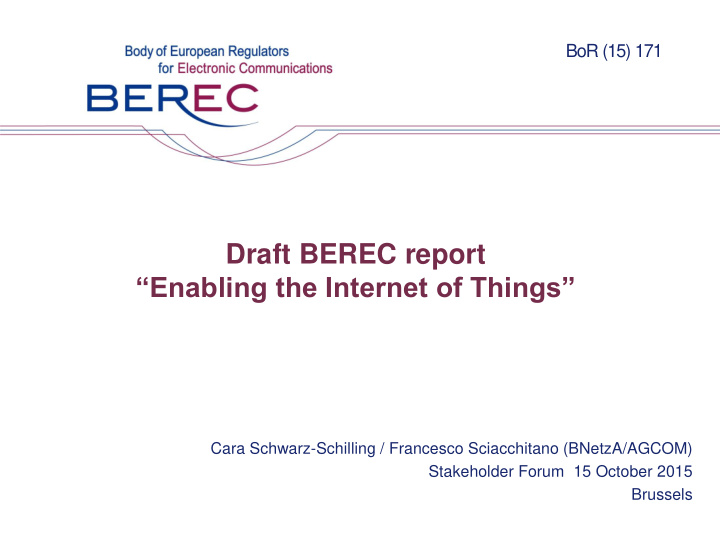



BoR (15) 171 Draft BEREC report “Enabling the Internet of Things” Cara Schwarz-Schilling / Francesco Sciacchitano (BNetzA/AGCOM) Stakeholder Forum 15 October 2015 Brussels
Characteristics Fully automatic (or with limited human intervention) communication of data from remote devices M2M communication patterns differ from personal communications Usually Low volume traffic, with sporadic/irregular patterns (signals) Relatively simple devices (both static and mobile) M2M services require connectivity, however connectivity accounts for a relatively low proportion of the overall revenue opportunity in the M2M value chain Many M2M devices produced for the world-market, hence many M2M services based on global mobility Many M2M devices designed to have a long lifetime Usually the business model is B2B, even if devices may be aimed at consumers (B2B2C) 2
A typical example for an M2M value chain End -User Connectivity M2M M2M Service Service End -User User Provider Provider End -User 3
Conditions for IoT/M2M to thrive 1. Sufficient resources in order to support the service – Section 2 Spectrum Identifiers (numbers and IP addresses) 2. Legal framework fit for IoT/M2M – Section 3 Regulatory Framework / Electronic Communication Service Roaming 3. Consumers ’ acceptance of M2M services – Sections 3.4 and 4 Privacy Network and Data Security Interoperability of services 4
Identifiers Many of the numbering issues NRAs currently have to tackle – and which are primarily dealt by CEPT and/or ITU on an international level – concern M2M services based on mobile connectivity: E.164 numbers/scarcity: national solutions E.212 numbers/”lock - in”: (see also “switching” section) Right to apply for own MNC/IMSI range (i.e. own SIM) for IoT/M2M-user? Or is OTA provisioning of SIM preferable ? Global marketing of connected devices: Permissibility of extra-territorial use of numbers? Use of international ITU numbering resources? Use of European numbering resources? DSM review: Still to be assessed whether need for special treatment 5
Regulatory Framework Applicable framework (e.g. notification regime) depends on finding of an electronic communication service (ECS) Art. 2 lit. c Framework Directive: an ECS is “a service normally provided for remuneration which consists wholly or mainly in the conveyance of signals on electronic communications networks, […]” . Within the IoT/M2M value chain: Connectivity service provider = ECS IoT/M2M-user = typically no ECS, unless reseller However, careful case-by-case approach since there are so many different types of packages including connectivity and since business models are just beginning to evolve. DSM review: Do existing rules (which were construed for voice telephony) also fit to M2M communications? 6
Roaming Many M2M services which use mobile connectivity are currently based on permanent roaming Permanent roaming might facilitate the creation of a truly European M2M market. Use of permanent roaming might in some instances reflect the absence of national roaming (aim: best coverage via all national networks). DSM review: Special treatment required Admissibility of permanent roaming in the M2M context Access right for permanent roaming in the M2M context (either by applicability of the Roaming Regulation or a separate legal document)? 7
Switching / “lock - in” issue If a customer intends to change connectivity service provider, it is currently necessary that the SIM is replaced physically. In the M2M-context, the costs of doing so might prevent switching the connectivity service provider (“lock - in”). Possible solutions: Own SIM for IoT/M2M-user (i.e. right to apply for own MNC/IMSI range) Over-the-air (OTA) provisioning of SIM Typically, E.164 number is not ported in case of change of service provider DSM review: Special treatment required Regulatory measures which foster OTA provisioning of SIM or make it mandatory? No right to number portability required in the M2M-context? 8
Privacy Personal data may be collected by a number of connected devices. The respect and protection of end- users’ privacy is a critical success factor for the realisation of the prospects and growth of IoT/M2M services. Current legal framework: Privacy Directive (Directive 95/46/EC) and sector- specific ePrivacy Directive (Directive 2002/58/EC as amended by Directive 2009/136/EC); no specific rules with regard to IoT/M2M. Revision of EU data protection framework under way, aim also to adapt privacy rules to digital era DSM review: No need for special treatment with regard to principles (e.g. principles like consent- based data collection and processing also apply in M2M context), But: Interpretation/Adaption for the M2M-context (e.g. user-friendly information and consent procedures) 9
Questions to stakeholders (1) 1. How do you evaluate the three options mentioned in the Draft Report, section 2.2.1.4 (extra-territorial use of national E.164 and E.212 numbers, use of global ITU numbering resources, use of a European numbering scheme) for the provision of M2M services? Which of these solutions is preferable to address the need for global marketing of connected devices? Should these solutions be used complementarily? 2. How do you regard the market situation in the M2M sector with regard to permanent roaming and national roaming? Which solution – OTA provisioning of SIM or MNC assignment to M2M users 3. – do you think is preferable to facilitate switching between connectivity providers in the M2M sector? Which advantages, which disadvantages are attached to the two solutions? 10
Questions to stakeholders (2) 4. Do you think there is a need to adapt Art. 13a of the Framework Directive to address security concerns in the M2M context? If so, which adaptations do you consider to be useful? 5. Do you think there is a need to adapt the Privacy Directive and ePrivacy Directive to address privacy concerns in the M2M context? If so, which adaptions? Do you think that the reform of the Privacy Directive as foreseen in the Council’s General Approach of 15 June 2015 on the future General Data Protection Regulation goes in the right direction? 6. What is the impact of open and proprietary standards on the development of the M2M sector? What are the advantages and disadvantages of open and proprietary standards, taking in account that M2M services may be provided on private or public networks? 11
Recommend
More recommend